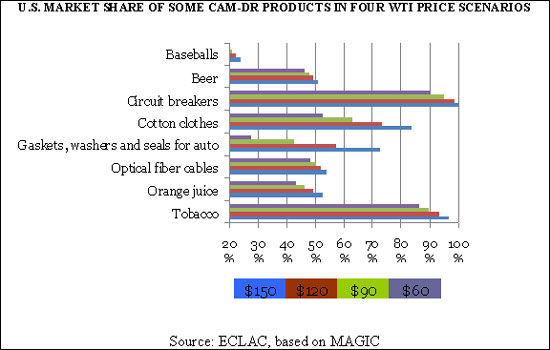Higher Oil Prices Expected to Benefit Exports of Central
America, Mexico and the Dominican Republic

Photo: thinkpanama, Flickr
The rise in oil prices in recent years has had a direct impact on transport costs for internationally traded goods, which has led to a change in the business strategies and consumer patterns that had prevailed in a context of low oil prices.
According to the study Effects of the rise in oil prices on the competitiveness of manufacturing exports from Central America, Mexico and the Dominican Republic, published by the ECLAC Subregional headquarters in Mexico, rising oil prices represent a window of opportunity for these countries to strengthen their exports.
Given that Central America, Mexico and the Dominican Republic share an export model based on “static” competitive advantages (particularly due to their proximity to the United States, low labour costs and tariff preferences), higher oil prices make their exports more competitive compared with those of nations further afield (especially in Asia).
On the other side of the balance sheet, it is vital to recognize that higher oil prices have tended to have a negative effect on net fuel importers (which applies to all of the countries studied except Mexico), with significant fiscal and inflationary costs.
The document was produced by the experts Carlos Guerrero and Ramón Padilla, and uses MAGIC software (Module for the Analysis of the Growth of International Commerce) developed by ECLAC. It contains information on the value and volume of all products (by tariff heading) imported by the United States.
The following figure shows the results of simulations involving various oil price scenarios. For instance, exports of women's T-shirts from Mexico to the United States would rise to 167 million dollars a year if oil prices were to reach 60 dollars per barrel, and would rise to over 220 million dollars a year if the price reached 150 dollars per barrel.

In order for these countries to make use of their geographical advantage, the study recommends strengthening transport competitiveness by extending and improving infrastructure, simplifying customs procedures and introducing new technologies. Other recommendations are to increase competitiveness in a broader sense, through strategic partnerships among Central America, Mexico and the Dominican Republic and the strengthening of countries' productive and technological capacities.
The ECLAC study ends with a warning. The export competitiveness of the countries analysed has relied heavily on what are known as static advantages. Two decades after the start of the export boom, Central America, Mexico and the Dominican Republic have been unable to take full advantage of the opportunities offered by globalization and business attraction. The windows that are ajar thanks to higher oil prices may only be open temporarily and can easily slam shut.
In this sense, the proposed scenario could be the trigger to activate local capacities, thereby enabling Central America, Mexico and the Dominican Republic to compete in the medium and long term, based on greater value added rather than lower costs (as demonstrated in the recent past).
| Higher oil prices offer a window of opportunity for strengthening the export competitiveness of Central America, Mexico and the Dominican Republic. | |
|
|
|
|
To make use of their geographical advantage, they must
strengthen transport competitiveness, expand infrastructure,
simplify customs procedures and introduce new technologies. |
|